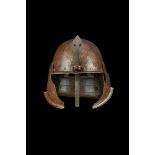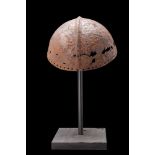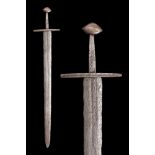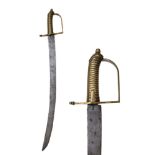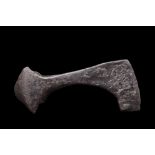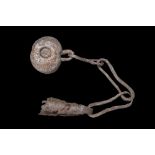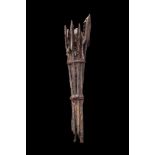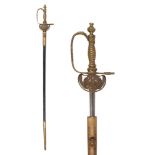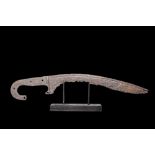Refine your search
Estimate
Category
- Arms, Armour & Militaria (147)
- Jewellery (96)
- Islamic Works of Art (67)
- Greek, Roman, Egyptian & Other Antiquities (56)
- Sculpture (51)
- Chinese Works of Art (48)
- Ceramics (45)
- Books & Periodicals (34)
- Salvage & Architectural Antiques (34)
- Glassware (29)
- Collectables (20)
- Porcelain (15)
- Metalware (14)
- Coins (10)
- Vintage Fashion (8)
- Scientific Instruments (7)
- Furniture (6)
- Kitchenalia (6)
- Sporting Memorabilia & Equipment (5)
- Tools (5)
- Lighting (4)
- Russian Works of Art (4)
- Taxidermy & Natural History (4)
- Clocks (3)
- Musical Instruments & Memorabilia (2)
- Textiles (2)
- Cameras & Camera Equipment (1)
- Classic Cars, Motorcycles & Automobilia (1)
- Entertainment Memorabilia (1)
- Ethnographica & Tribal Art (1)
- Indian Works of Art (1)
- Models, Toys, Dolls & Games (1)
- Oil, Acrylic paintings & Mixed Media (1)
- Silver & Silver-plated items (1)
- Writing Instruments (1)
- List
- Grid
A subscription to the Price Guide is required to view results for auctions ten days or older. Click here for more information
A POLISH HUSSARS HELMET
Ca. 17th-18th century AD. Polish-Lithuanian Commonwealth, 2nd half of 17th century. From a classical Polish hussars armour of so-called winged hus...
Ca. 17th-18th century AD. Polish-Lithuanian Commonwealth, 2nd half of 17th century. From a classical Polish hussars armour of so-called winged hus...
Ca. 17th-18th century AD. Polish-Lithuanian Commonwealth – Saxony, 17th-18th century, period of the reign of August II the Strong, who was king of...
Ca. 17th century AD. Round skull with many vertical grooves and ridges, lower part decorated with rivets, mushroom-shape peak on the top. Part of ...
Ca. 9th century AD. Rectangular strap loop connected to the high stirrups by a short bar. The solid and thick stirrups flattened just before the t...
Ca. 19th century AD. A sabre sword. This exquisite weapon is a stunning example featuring a curved fullered blade with a pointed tip. The hilt is ...
Ca. 17th century AD. Round one-piece skull with nice traces of hammering. Horizontal visor, fixed to the skull with rivets. Hole for the face guar...
Ca. 18th century AD. A small sword, a symbol of elegance and sophistication during the 18th century. This fine example boasts a long and slender b...
Ca. 17th century AD. A cone shape skull with a high peak and a ridge in the front and back sides of the skull. Horizontal visor with a hole for a ...
Ca. 18th century AD. An elegant French small sword, a weapon that epitomizes the sophistication and artistry of the 18th century. This exquisite w...
The Caucasus, ca. 19th century AD. With a pointy blade with three grooves, the silver-mounted filigree-decorated scabbard is richly chiseled and d...
Ca. early 20th century AD. Silver mounted dagger with hilt and scabbard decorated in chiseling niello, straight double-edged blade with two fuller...
GERMAN LOBSTERTAIL HELMET
Ca. 17th century AD. Round skull with horizontal visor, vertical part of which covers a significant part of the skull, making the front side of th...
Ca. 1350-1450 AD. An excellent forged-iron long sword with broad blade tapering to a sharp point. About a hands breadth below the cross guard is a...
VIKING IRON SWORD
Ca. 900-1000 AD. An iron forged sword featuring a broad blade with parallel edges, tapering to a sharp point, ideal for piercing armor and deliver...
Ca. 19th-20th century AD. A fine sword executed in a 15th-century style features a broad blade, tapering to a sharp point, ideal for delivering po...
VIKING IRON SKULL CAP
Ca. 9th-13th century AD. A rare iron skull-cap, crafted in the shape of a hemisphere to fit snugly over the human head. The design of this piece i...
Ca. 1100 AD. A hand-forged iron sword comprising of a narrow two-edged blade with shallow fuller to both faces, short ricasso, slender square-sect...
MEDIEVAL IRON DAGGER
Ca. 900-1100 AD. An iron military dagger comprising a short triangular blade with thick midrib and tapering edges, narrow point, cross guard with ...
MEDIEVAL VIKING IRON SWORD
Ca. 900-1000 AD. An iron sword In excavated condition, with a broad double-edged blade, the hilt comprising thick ovoidal cross-piece, flat slight...
Ca. 1000-1100 AD. An iron sword with a distinctive Brazil nut pommel, Oakeshott type A. The cross guard is long, thin, and square-sectioned, in Oa...
Ca. 1100-1200 AD. With broad double-edged blade with wide shallow fuller over nearly its entire length on both sides, hilt comprising slightly arc...
MEDIEVAL IRON SWORD
Ca. 1100-1200 AD. A forged-iron sword with a slender hand guard and a discoid pommel. The cross-style two guard has a slight central protrusion on...
Ca. late 19th early - 20th century AD. Masonic sword for the "Knights Templar" order ceremony, with scabbard, offered to Irvin S. Smith, Ricasso m...
Ca. 1767-1791 AD. A rare French hanger from the American revolution with an iron hand forged by a blacksmith. The sword was made at the time of th...
AN EXTREMELY RARE SWISS GRENADIER HANGER (SWISS GUARD AT THE SERVICE OF KING LOUIS XVI) MODEL 1792
Ca. 1792 AD. A rare Swiss Grenadier hanger (Swiss guard at the service of King Louis XVI), model 1792, built on the 1782 model "sabre de bord" mad...
Ca. 1908 AD. An Imperial Russian Dragoon officer’s saber, model 1909. Brass hilt with wooden grip and monogram of Nicholas II. The curved blade ha...
Ca. 1808 AD. A rare Napoleonic war saber "Briquet", model 1767, dating from the invasion of Spain by Napoleon the 1st in 1808. Brass hilt with D-s...
MEDIEVAL IRON FALCHION
Ca. 1300-1400 AD. An iron falchion with a single-edged, asymmetric blade, with a short back edge, the hilt gently tapering to the left side ending...
MEDIEVAL IRON SWORD
Ca. 1100-1125 AD. A hand-forged sword blade of a Viking or Norman type, comprising of a long, gently tapering blade with a straight double-edged b...
MEDIEVAL IRON FALCHION
Ca. 1300-1400 AD. An iron falchion with a single-edged, curved blade, with a short back edge, The cross style two guards has a slight central prot...
Ca. 1850 AD. Shortsword of the canteen women with a brass ribbed hilt, diamond-shaped straight double-edged blade, original stitched black leather...
Ca. 1802-1803 AD. An extremely rare saber Briquet de marine, model AN XI, Napoleon Bonaparte 1st consul. Brass D-shaped hilt with ribbed handle, m...
Ca. late 19th century AD. A French hunting dagger with a straight blade with one wide fuller on each side. The blade is decorated with etching. Th...
Ca. 1300 AD. An iron dagger with a slender cross-shaped hand guard and a square pommel. The narrow tapering blade is straight on the top edge, the...
Ca. 1400-1500 AD. An iron dagger or stiletto featuring a double-edged slender blade with a button-shaped cross guard, rectangular-section tang fin...
Ca. 900-1300 AD. A group of iron knife blades comprising of a slender cutting edge and a long tang. Such cutler knives were popular from Roman to ...
20th century AD. A trio of orders, each a shining emblem of Poland's rich history and cultural legacy. Three crosses, adorned with baubles and cra...
Ca. 1100 AD. An iron-forged single-edged knife or seax with a thick back, ellipsoid lower guard, short tang, and thin handle. This fighting-knife,...
VIKING IRON AXE HEAD
Ca. 900-1100 AD. An iron axe-head of the Petersen B type is characterized by its long, down-facing bearded blade, which is curved along its cuttin...
Ca. 1300-1500 AD. Forged in iron with a wooden dagger with a lengthy blade and a thick handle. The wood covers the tang, forming a round pommel, g...
Ca. 13th-14th century AD. An iron flail with chain, a weapon of unparalleled ferocity and power. This deadly instrument, crafted with a masterful ...
GROUP OF SCYTHIAN ARROWS
Ca. 700 BC. A group of Scythian arrows in excavated condition tied in rope together with natural materials. Each featuring a barbed shape, with a ...
VIKING IRON BATTLE AXE
Ca. 900-1100 AD. An iron bearded axe head with an elongated, curved blade and tapering cheek. The bearded axe, or Skeggøx (from Old Norse Skegg, "...
Ca. late 19th century AD. An antique American Masonic Knights Templar York Rite ceremonial sword with an etched blade holding a crowned Passion Cr...
Ca. 19th century AD. The Caucasian shashka with scabbard. Blade of slight curvature with one fuller on each side with engraving in the form of a b...
Ca. 1855 AD. Russian M1855 court sword. Gilt-brass hilt and mounts, clam-shell features the Imperial Russian eagle. Flattened straight blade. The ...
Ca. 1300 AD. An iron dagger with a slender hand guard and a square pommel decorated with floral inlay. The cross-style two guard has a slight cent...
Ca. 1400 AD. A hand-forged single-edged dagger with triangular-section blade, elliptical guard with arched profile, tapering tang, and rondel-styl...
MEDIEVAL IRON DAGGER BLADE
Ca. 1100-1300 AD. An iron dagger with a long blade and an exposed tang without a pommel a the end. Now missing. The blade has a prominent midrib t...
IBERIAN FALCATA SWORD
Ca. 300-200 BC. A single-edged machaira sword of falcata typology, with a curved hilt of regular geometric shape; grooves on one side of the upper...
Ca. 900-1300 AD. A single-edged iron scale-tang knife with a triangular blade, recess to one face of the tang, five rivet-holes to the tang, and o...
Ca. 1300 AD. A large octagonal pommel with a circular central recess on each face. Cf. Oakeshott, E., The sword in the Age of the Chivalry, Woodbr...
Ca. 1940 AD. U.S. World War II Naval Officer’s Dress Sword. It was imported by Hilborn Hamburger from Soligan, Germany. Stainless steel blade etch...
Ca. 1767 AD. A cutlass specially made for the Navy from the American Revolution and Napoleonic wars, brass D-shaped hilt with ribbed handle, stamp...
Ca. 1845 AD. A French Infantry officer’s sword, M1845, was used during Civil War. The grip is wrapped in original shagreen leather. The ricasso is...
Ca. 1300-1500 AD. A short iron double-edged dagger with a slightly curved sculptured cross guard with incised decoration and tapering tang to braz...
Ca. 1300-1400 AD. A fine rondel dagger made from iron with the signature disc-shaped guard and pommel. The blade is long and slim with a double ed...
Ca. 1400-1500 AD. A Medieval dagger/stiletto with a long thin blade and handle. The cross guard is a square section bar in the middle but is shape...
Ca. 1200-1300 AD. An interesting iron dagger of a quite lethal form. Blade sharpened on each edge, Cross hilt, thin handle once supporting a woode...








